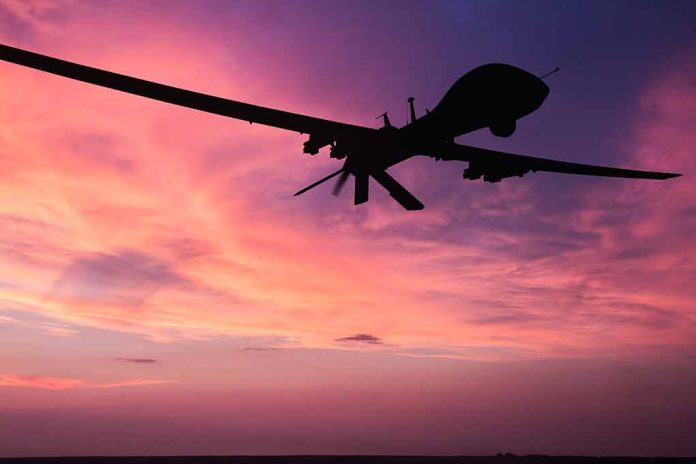
Israel’s precise airstrikes have obliterated Iran’s iconic F-14 Tomcat fighter jets, effectively grounding the last remnants of the Islamic Republic’s aging American-built air defense and drastically altering the Middle East’s military balance of power.
Key Takeaways
- Israeli forces destroyed two Iranian F-14 Tomcats during strategic airstrikes in Isfahan, targeting jets that were “intended to intercept Israeli aircraft”
- The destroyed F-14s were part of Iran’s dwindling fleet of these iconic American fighters, acquired before the 1979 Islamic Revolution and made famous by the movie “Top Gun”
- Iran has struggled to maintain its F-14 fleet for decades due to U.S. arms embargoes, relying on cannibalized parts and black market procurement
- The strikes are part of Israel’s broader campaign to dismantle Iran’s air defense capabilities, potentially marking the end of the F-14’s operational life in Iran
- With replacement Russian Su-35s diverted to Algeria, Iran faces a critical gap in its air defense capabilities as the conflict intensifies
Israel’s Strategic Strike Against Iran’s Aging Air Fleet
The Israel Defense Forces (IDF) has dealt a crippling blow to Iran’s air defense capabilities by destroying two F-14 Tomcat fighter jets at Tehran’s Mehrabad International Airport. The precision strike, captured on infrared targeting camera footage, shows the American-built fighters being obliterated by air-to-ground munitions while sitting outside hardened aircraft shelters. IDF Spokesman Brigadier General Effie Defrin confirmed the operation during a press conference, stating, “An Israeli Air Force drone struck and destroyed two Iranian F-14 fighter jets at an airport in Tehran.”
The destroyed aircraft represent a significant portion of Iran’s limited operational F-14 fleet, which has been steadily dwindling since the 1979 Islamic Revolution cut off Iran’s supply of American parts and technical support. According to military analysts, these jets were specifically “intended to intercept Israeli aircraft,” highlighting their strategic importance in Iran’s increasingly desperate air defense strategy against Israeli incursions.
The Last Days of Iran’s “Persian Tomcats”
The F-14 Tomcat holds a unique place in military aviation history. Made famous by the movie “Top Gun,” this 55-year-old fighter was retired by the U.S. Navy in 2006, leaving Iran as the only country still operating the iconic aircraft. Iran originally acquired 79 F-14s from the United States before the Islamic Revolution severed diplomatic relations. In the decades since, maintaining these sophisticated aircraft has become increasingly challenging due to comprehensive U.S. arms embargoes and technological obsolescence.
“The Israel Defense Forces (IDF) posted infrared targeting camera footage of a pair of F-14A Tomcat fighters being destroyed by air-to-ground munitions as they sat outside hardened aircraft shelters at Mehrabad International Airport in Tehran.”
Iran has resorted to extraordinary measures to keep a small number of F-14s operational, including cannibalizing parts from grounded aircraft, reverse engineering components, and sourcing replacement parts through black market channels. Despite these efforts, the Islamic Republic of Iran Air Force (IRIAF) has been forced to operate two categories of F-14s: Partially Mission-Capable (PMC) jets used primarily for training, and a limited number of Fully Mission-Capable (FMC) aircraft reserved for actual combat operations.
Israel’s Systematic Dismantling of Iran’s Air Defenses
The destruction of these F-14s is not an isolated incident but part of a broader Israeli campaign to methodically dismantle Iran’s air defense network. The strategy aims to create conditions that would allow Israeli forces to operate freely over Iranian airspace, preventing the reconstitution of Iran’s nuclear and missile programs. By targeting multiple air bases across Iran, the IDF is systematically eliminating the Islamic Republic’s tactical jet fleet, which has already been severely compromised by decades of international sanctions.
“These jets were intended to intercept Israeli aircraft,” stated IDF.
The F-14s had been providing quick reaction alert coverage for Tehran, serving as a last line of defense for the Iranian capital. With their destruction, Iran has lost a symbolic and practical component of its air defense strategy at a critical moment in the escalating conflict with Israel. The precision of these strikes also demonstrates Israel’s superior intelligence capabilities and the effectiveness of its long-range strike platforms, sending a clear message about the vulnerability of Iran’s military assets.
Iran’s Air Defense Gap and Uncertain Future
The loss of these F-14s creates a significant capability gap in Iran’s air defense network that may prove impossible to fill in the short term. Iran had been counting on deliveries of Russian-made Su-35 fighters to modernize its air force, but reports indicate that some of these aircraft have been diverted to Algeria instead. With the conflict between Israel and Iran intensifying—having already resulted in 224 deaths in Iran and 24 in Israel—the Islamic Republic’s ability to defend its airspace appears increasingly compromised.
Military analysts widely believe that it is unlikely Iran will have any operational F-14s remaining after this conflict, marking the definitive end of the Tomcat’s remarkable 45-year service with the Iranian Air Force. This development represents not just the loss of iconic aircraft but a significant degradation of Iran’s defensive capabilities at a time when the regime can least afford such setbacks. As Israel continues its campaign against Iran’s military infrastructure, President Trump’s strong support for Israel’s right to self-defense reinforces the shifting balance of power in the region.







